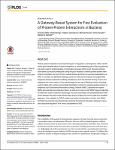A Gateway-Based System for Fast Evaluation of Protein-Protein Interactions in Bacteria
Wille, Thorsten
Barlag, Britta
Jakovljevic, Vladimir
Hensel, Michael
Sourjik, Victor
Gerlach, Roman
Protein-protein interactions are important layers of regulation in all kingdoms of life. Identification and characterization of these interactions is one challenging task of the post-genomic era and crucial for understanding of molecular processes within a cell. Several methods have been successfully employed during the past decades to identify protein-protein interactions in bacteria, but most of them include tedious and time-consuming manipulations of DNA. In contrast, the MultiSite Gateway system is a fast tool for transfer of multiple DNA fragments between plasmids enabling simultaneous and site directed cloning of up to four fragments into one construct. Here we developed a new set of Gateway vectors including custom made entry vectors and modular Destination vectors for studying protein-protein interactions via Fluorescence Resonance Energy Transfer (FRET), Bacterial two Hybrid (B2H) and split Gaussia luciferase (Gluc), as well as for fusions with SNAP-tag and HaloTag for dual-color super-resolution microscopy. As proof of principle, we characterized the interaction between the Salmonella effector SipA and its chaperone InvB via split Gluc and B2H approach. The suitability for FRET analysis as well as functionality of fusions with SNAP- and HaloTag could be demonstrated by studying the transient interaction between chemotaxis response regulator CheY and its phosphatase CheZ.
No license information
Related Items
Show related Items with similar Title, Author, Creator or Subject.
-
2013-08-08ZeitschriftenartikelCytomegalovirus Downregulates IRE1 to Repress the Unfolded Protein Response Stahl, Sebastian; Burkhart, Julia M.; Hinte, Florian; Tirosh, Boaz; Mohr, Hermine; Zahedi, René P.; Sickmann, Albert; Ruzsics, Zsolt; Budt, Matthias; Brune, WolframDuring viral infection, a massive demand for viral glycoproteins can overwhelm the capacity of the protein folding and quality control machinery, leading to an accumulation of unfolded proteins in the endoplasmic reticulum ...
-
2012-12-21ZeitschriftenartikelProtein-Protein Interaction Domains of Bacillus subtilis DivIVA Baarle, Suey van; Celik, Ilkay Nazli; Kaval, Karan Gautam; Bramkamp, Marc; Hamoen, Leendert W.; Halbedel, SvenDivIVA proteins are curvature-sensitive membrane binding proteins that recruit other proteins to the poles and the division septum. They consist of a conserved N-terminal lipid binding domain fused to a less conserved ...
-
2013-03-11ZeitschriftenartikelTowards further reduction and replacement of animal bioassays in prion research by cell and protein misfolding cyclic amplification assays Boerner, Susann; Wagenführ, Katja; Daus, Martin L.; Thomzig, Achim; Beekes, MichaelLaboratory animals have long since been used extensively in bioassays for prions in order to quantify, usually in terms of median infective doses [ID50], how infectious these pathogens are in vivo. The identification of ...

